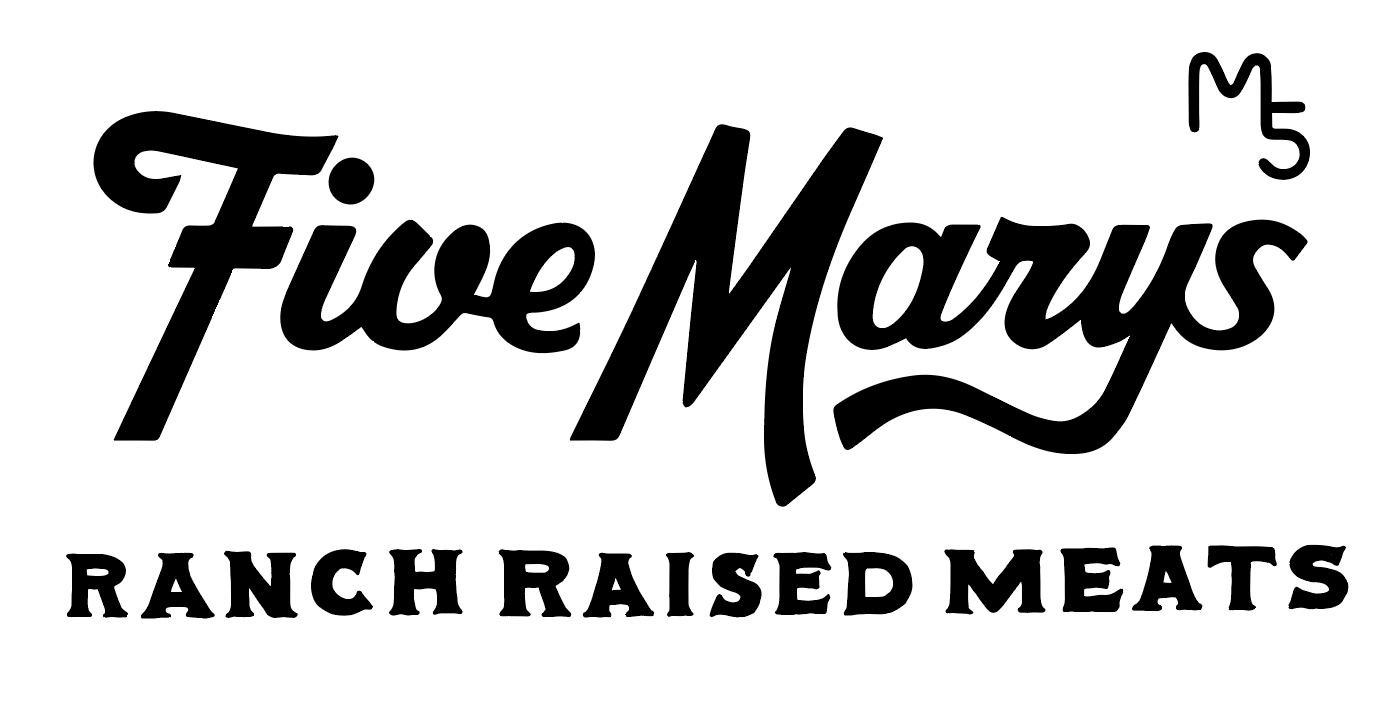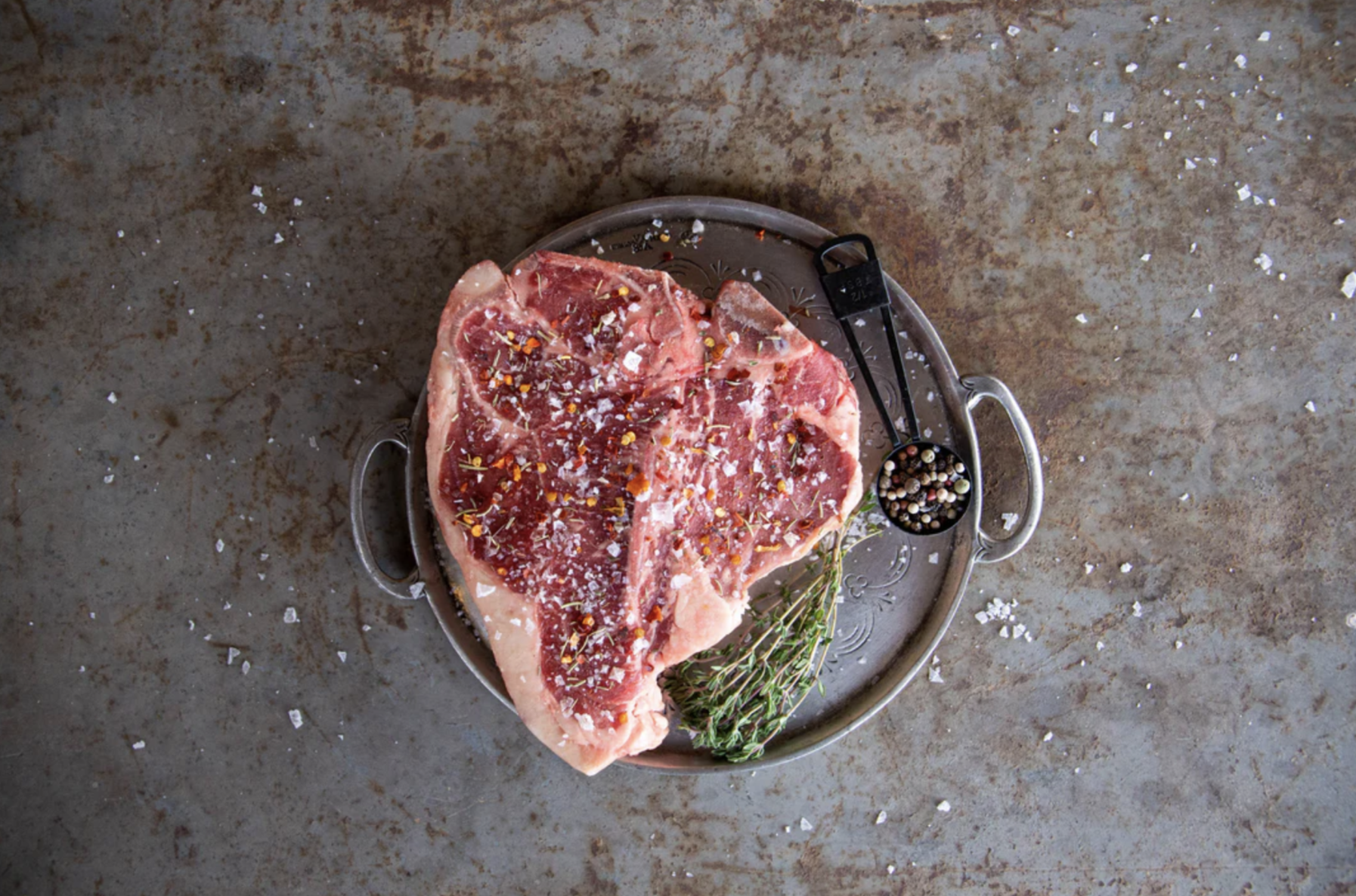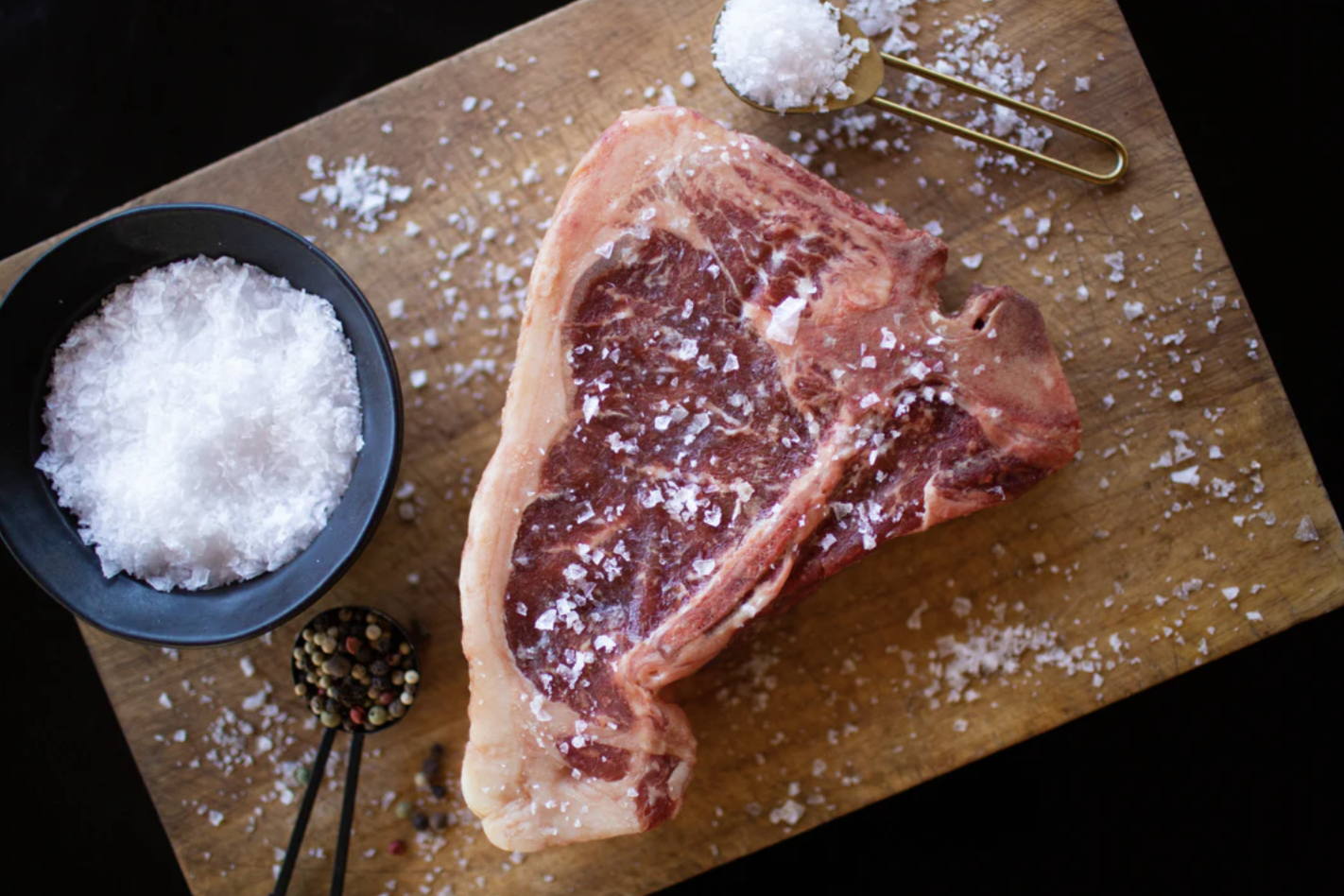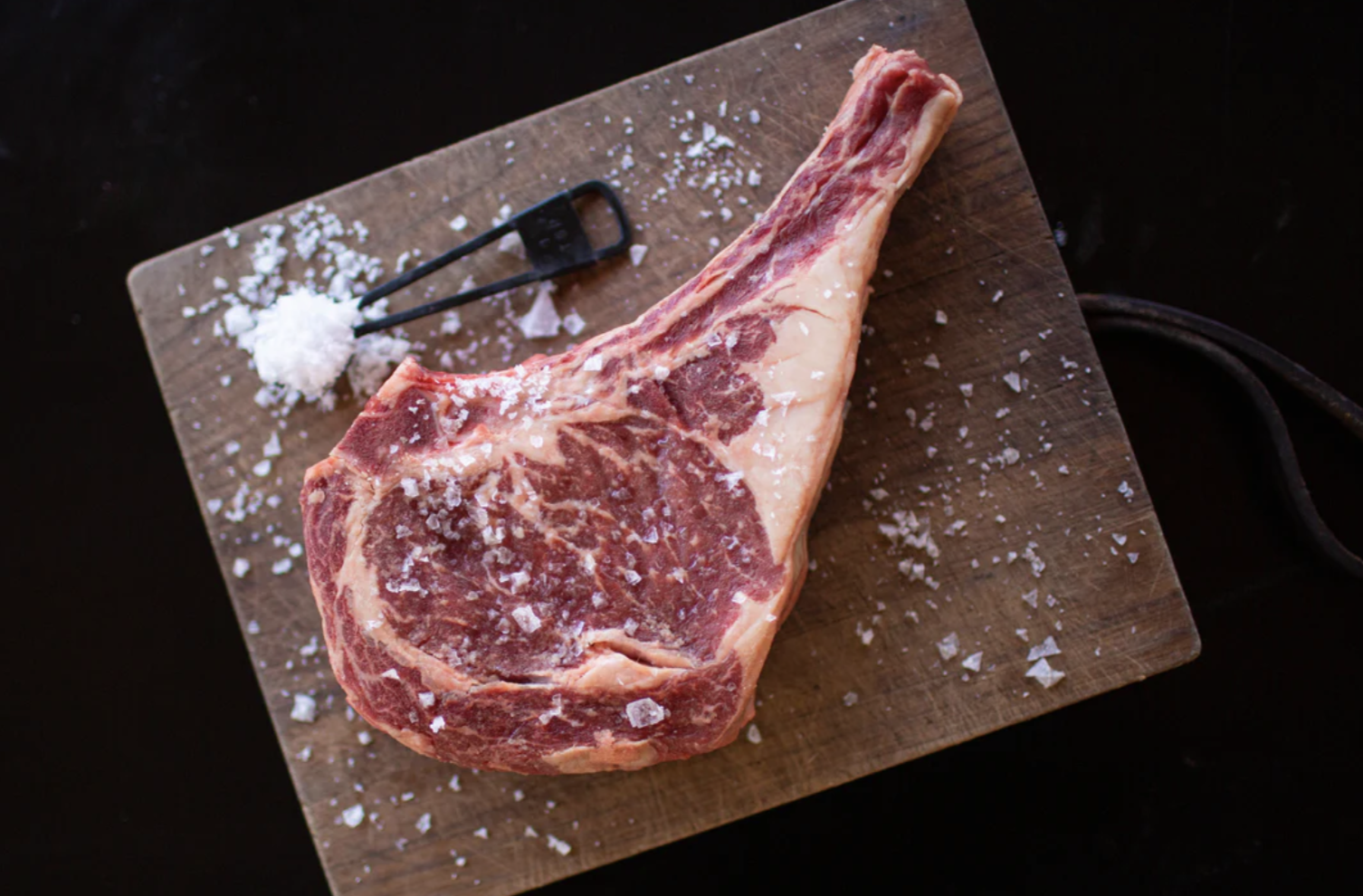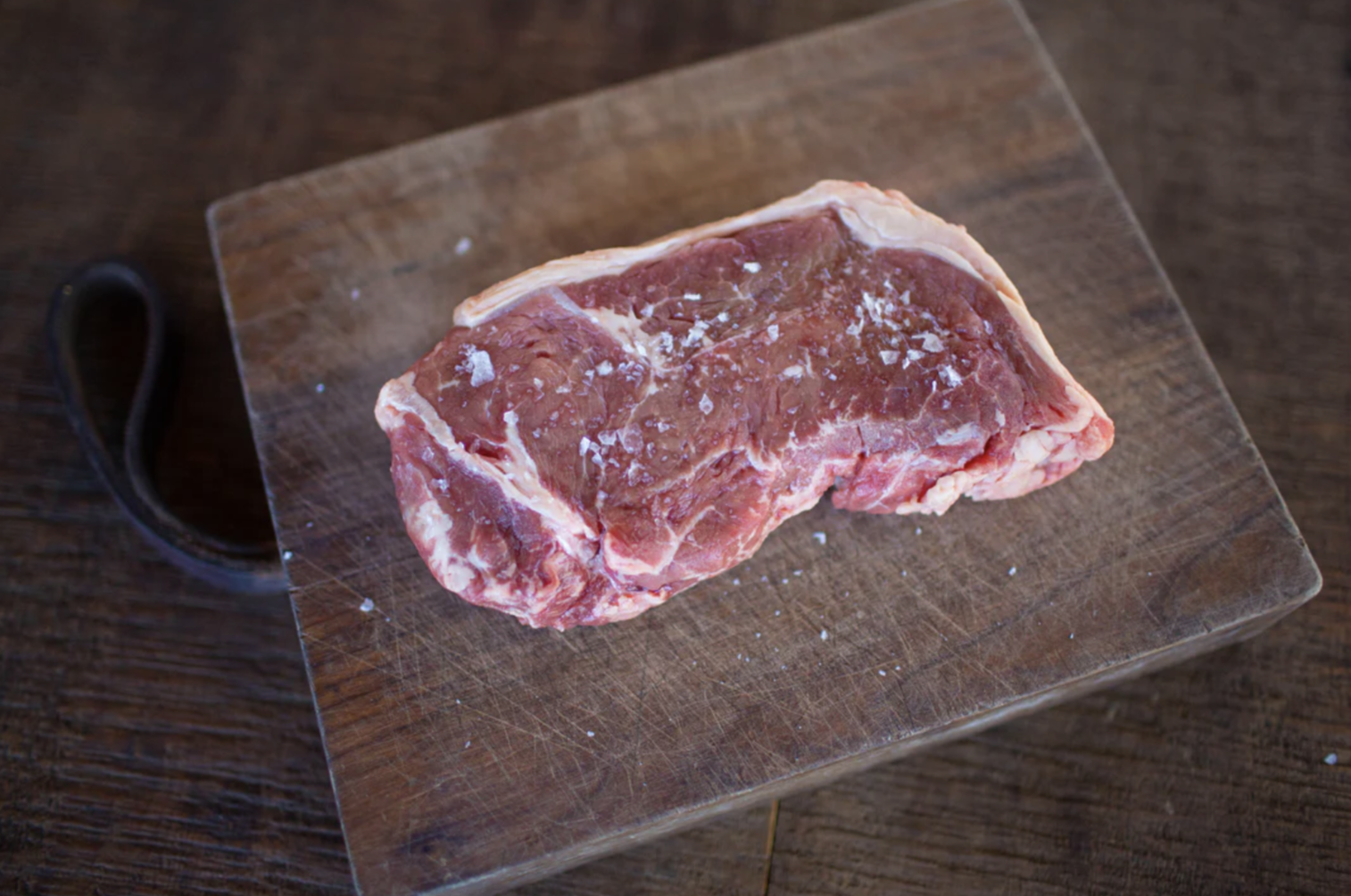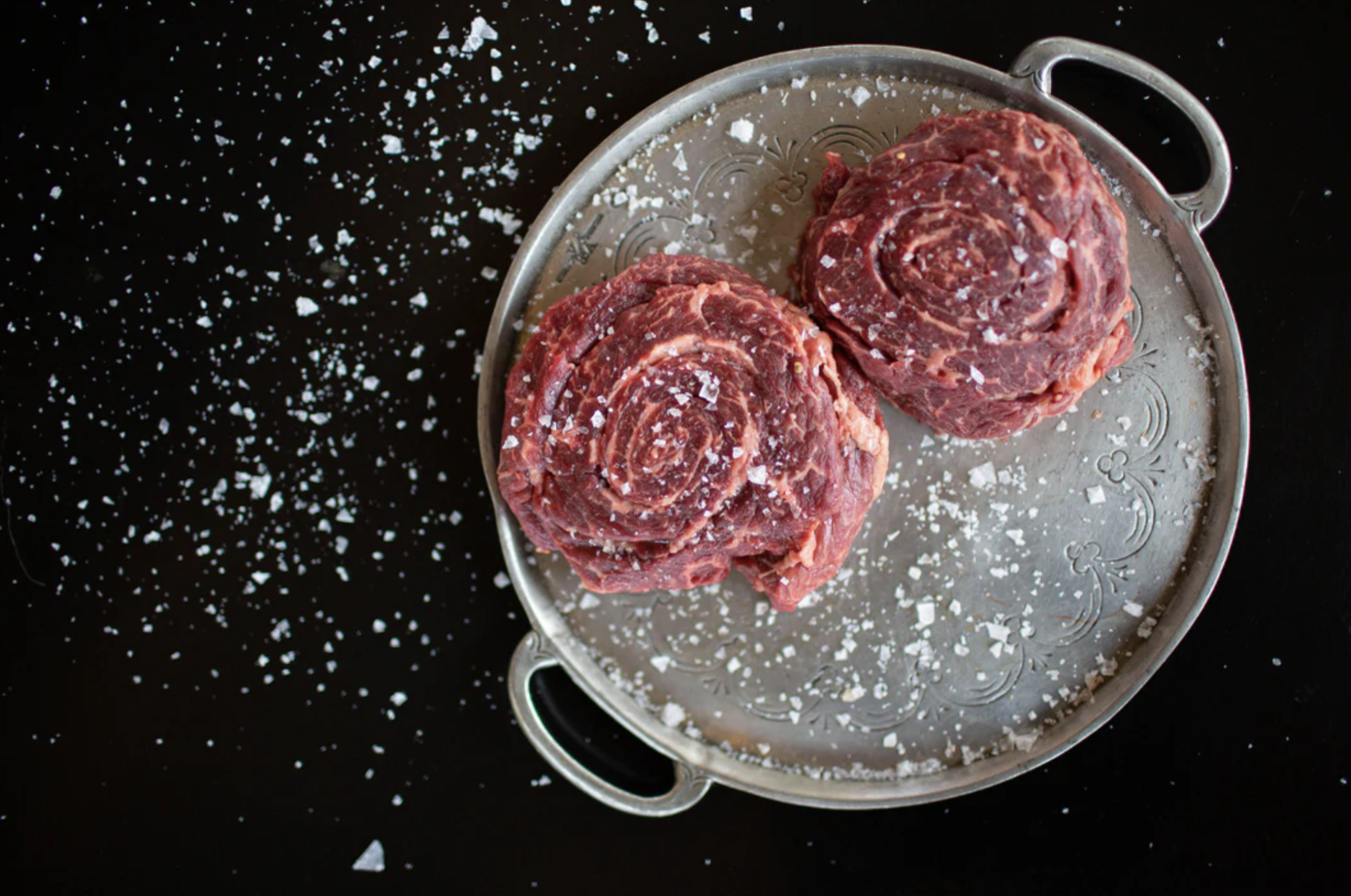How to Cook Your Steak
When you have high-quality meat cuts, you don't need to add a whole list of ingredients to it... it should speak for itself! My favorite thing to add to our steaks is a little bit of olive oil, butter, thyme, salt, and pepper (or just some M5 spice rub!). Cooking a great steak can sound intimidating, but just follow these recipes and you'll be cooking up your own awesome steaks in no time.
Porterhouse, T-Bone, Rib Eye, and New York Strip Steaks
The porterhouse may be the best steak you’ve ever had. Very similar to the T-Bone steak, it is located in the very back of the short loin, and therefore has a larger piece from the tenderloin than a T-bone does. It is both the New York steak and filet mignon in one! Like all short loin steaks, it is unbelievably tender with a rich, mouthwatering flavor.
T-Bone steaks, like porterhouse steaks, include a ‘T-shaped’ bone which seperates the strip steak and the tenderloin. The T-bone steak is located in the middle of the short loin where it interacts with the tenderloin cut (the short loin and tenderloin are the most prized cuts of a cow). In effect, a T-bone comprises meat from a New York strip and a filet, thus making it a prized and delicious steak. Cook to medium-rare on a grill or cast-iron pan.
The New York strip steak is a premium steak, known for its tenderness and buttery flavor. This steak is perfect for grilling, pan-searing, or sauteing for an impeccable steak dinner that can’t be beat.
Rib eye steaks are one of the most prized on a steer. At Five Marys, all rib eye steaks come bone-in. In the anatomy of a cow, rib eyes sit directly above the short ribs and weight between 1 and 3 pounds. They are tender, beautifully marbled, juicy, and full of flavor. For optimal taste and texture, this cut should be cooked fast, using high heat methods such as grilling, pan searing, and sautéing.
Allow your steak to come to room temperature. I prefer a medium-rare steak. If you prefer your steak cooked more or less, simply add or subtract the time. Heat a well-seasoned cast iron pan over medium-high heat. Melt some butter and olive oil in the pan. Generously season the steak on both sides and place in the hot pan (or on a hot grill).
Turn the steak every 2 minutes to caramelize the entire surface area. If the pan begins to smoke, turn it down a touch. The steak should be a medium rare in 10-12 minutes. Rest the finished steak for 10 minutes before slicing…. and enjoy!
Tomahawk Steak
The tomahawk steak (or the ‘Tommy’ as M5 staff affectionally call it) is a novelty steak, comprised of the rib eye steak, but with the entire rib bone intact (5+ inches of bone). It is sometimes called the long-bone rib eye because of this. The extra length of bone is ‘French trimmed’ so that the meat and fat are removed to leave the handle of the ‘tomahawk’ bare. The tomahawk is cut to be thicker than a typical rib eye, with a width between 2 and 3 inches.
Grilling or oven roasting a tomahawk will the be best methods for cooking. Season your steak with salt and pepper (or M5 spice rub) and allow it to reach room temperature. Fire up your grill and let it reach a temperature of 225-250 degrees F and pile up your charcoals to one side of the grill (you’ll be cooking your steak over indirect heat).
Place your tomahawk onto the grill (the side away from the coals) and put the lid on. Grill until the steak turns golden brown and the internal temp reaches 115-120 degrees F. This will take about 30-40 minutes. After it has reached the correct temperature, you’ll want to spread back out your charcoals so you’re now grilling over direct heat.
When the grill is hot, place your steak back on the grill and cook for about 3 minutes on each side. Take the steak off the grill when it reaches 125-130 degrees F. Remember that the temperature will continue to rise as the steak rests (you want a final temperature of 135 degrees F for a perfect medium rare). Add some butter to your tomahawk and cover it with a foil tent for about 10 minutes before slicing and serving!
Flank Steak
The flank steak is a rare cut taken from the lower abdomen of the cow. One steer produces only two of these desirable cuts. It is often confused with the skirt steak, which is taken from the plate of a cow. The flank steak is the leaner of the two. It is a versatile, thin, flavorful steak - best when sliced against the grain. I love it in steak salads, fajitas, and tacos. It should be cooked medium-rare to ensure the most flavor and tenderness.
To marinate your steak, in a small bowl, whisk together olive oil and your favorite spices. I either use M5 spice rub, or a mix of cumin, oregano, salt, and pepper. Put the steak in a baking dish and pour the marinade over it, turning to coat. Cover and refrigerate for at least 30 minutes or up to 10 hours. To cook the steak, prepare a charcoal grill for direct cooking over medium-high heat (400-450 degrees F) or heat a stovetop grill pan over medium-high heat.
Brush the grates clean. Grill the steak with the lid closed, only turning once halfway through, until cooked to the preferred doneness, 8-10 minutes total for a medium-rare. Transfer the steak to a cutting board to rest for 5 minutes. Cut the steak against the grain into 1/4-inch-thick slices and enjoy!
Filet Mignon
The filet mignon is the most tender steak on a cow, and also very lean with minimal fat. It is perfect for special occasions or those monitoring their fat intake. It is located in the smallest part of the tenderloin, which stretches into the short loin. This cut is highly desired and rare on a cow, and therefore, an expensive, premium cut. Its flavor can be further enhanced when wrapped in bacon or drizzled with sauce.
Preheat your oven to 415 degrees F. Season your steak with salt and pepper. and let it reach room temperature. Heat a cast-iron skillet on high heat with butter and sear your filets for about 2 minutes on each side. Immediately transfer your filets (still in the skillet) to the preheated oven and cook for about 5-6 minutes for a medium rare.
Depending on the size of your filet, you may need more of less time. Remove your filets from the skillet and let them rest for 10 minutes before serving. Remember that your steak will still rise in temperature while it is resting… don’t overcook your filets or they will become tough.
Top Sirloin Steak
The top sirloin is comparable to a T-bone or porterhouse, but without the price tag! It is tender, flavorful, and a family dinner favorite. Unlike the T-bone and porterhouse, it is boneless and does not include any meat from the tenderloin. Add your favorite spice rub and cook on a grill or pan-sear for a fantastic steak dinner. I especially love slicing mine into strips and adding to nachos!
Place your top sirloin steaks in a baking dish and pour your marinade over it, turning to coat. Cover and refrigerate for at least 30 minutes or up to overnight. When you’re ready to cook, prepare a grill for direct cooking over medium high heat (400-450 degrees F) or heat a cast-iron stovetop grill pan. Remove the steak from the marinade and shake off the excess. Place the steak on the grill and cook, turning once, until nicely browned. This will take about 5-7 minutes for medium-rare depending on how thick the steak is (using a meat thermometer makes it easy!).
When your steak reaches about 130 degrees F, transfer it to a cutting board and let it rest for 5-10 minutes. When it hits 135 degrees F, you’ll have yourself a perfect medium-rare. Slice the steak across the grain and enjoy!
Skirt Steak
The skirt steak, which is similar to the flank steak, is a rare cut - only two skirt steaks can be cut from a single cow. It is long, thin, and so flavorful. It’s perfect for marinating and grilling. Cook to medium or medium-rare for the best results.
Cut your skirt steak into 2 or 3 smaller sections. Pat the steaks with paper towel until they are dry. Generously season them with salt and pepper (or M5 spice rub). Heat a cast-iron pan and once it’s hot, add some butter or olive oil. Sear the steaks until they are browned - about 2 to 4 minutes on each side.
Use a meat thermometer and cook the steak until it reaches a temperature of 130 degrees F. Let the steak rest for about 10 minutes and slice across the grain into thin strips. Serve with some roasted veggies and couscous!
Hanger Steak
The hanger steak is located in the plate section of a cow and ‘hangs’ from the diaphragm (hence its name). It is also known as the ‘butcher’s steak’ because historically, butchers would keep it for themselves instead of selling it at market - they know a good cut when they see one! To this day, it is difficult to find in grocery stores and meat shops. It is incredibly delicious and just as tender as the prized tenderloin cuts. Hanger steaks are best prepared quickly, either through broiling, grilling, or in a sizzling hot cast-iron skillet.
Let your hanger steak come to room temperature and generously season with salt and pepper. When your grill is nice and hot, place the hanger steak on the center of the grill and sear for 2-3 minutes on each side. Use a meat thermometer and remove the steak from the grill when it reaches 125-130 degrees F. Tent the steak with foil and let it rest for about 10 minuets. Slice across the grain and enjoy!
Picanha
The picanha is a large cut, hugely popular in Brazil and other South American countries - it is a staple at Brazilian steakhouses. In the United States (if you can find it), it is sometimes called the Coulette roast or steak, or the top sirloin cap. It is the top most layer of the top sirloin cut on a cow, and therefore has an incredible fat cap. It is delicious and flavorful, perfect for grilling and pan-searing when cut into steaks.
Heat your grill to about 400 degrees F. Score the fat cap in a crosshatch pattern - don’t cut too deep… stay within the fat cap. Season the steak M5 spice rub and cut into 1-inch strips. Fold each strip into a c-shape and place them on metal skewers. Grill over indirect heat (away from the coals) with the fat side up, for about 20 minutes, or until it reaches 130 degrees F. Turn every 5 minutes or so. Let the steaks rest for about 10 minutes before slicing against the grain… enjoy!
California Tri-Tip
The California tri-tip is a triangular muscle at the bottom of the sirloin. This cut is especially famous on the west coast because it was first popularized in California in the 1950’s. In the east, it is typically used for ground beef. It is a rare cut, with only two on each cow. California tri-tip, or Santa Maria steak, is a delicious, low-fat, and versatile cut which can be grilled, pan-seared, or oven-roasted to medium-rare for best results. It is perfect for chili con carne, tri-tip tacos, or single-pan steak for fajita dinners.
Let your tri-tip come to room temperature before cooking. Season it with salt, pepper, and any of your favorite spices! I like our M5 spice rub with this one :) Sear your tri-tip on a hot grill… watch it carefully! As the fat heats up, it might drip down and cause some flames to come up. Whenever that happens, just keep moving your tri-tip around the grill.
Cook until the internal temperature reaches 130 degrees F (for a great medium-rare). Use a meat thermometer to track the temperature. Let the tri-tip rest for about 10 minutes (remember that the internal temperature will continue to rise as it rests). Slice against the grain and enjoy!
Top Round Steak
Also known as the London Broil, or fajita steak, the top round steak is a tender, lean, and versatile cut of meat - perfect for stir-fry, fajitas, and other broiled, pan-friend, or slow-cooker meals. It should be thinly sliced against the grain.
Slice your top round steak into strips as thinly as possible. A partially-frozen steak slices with ease. Season the strips with olive oil, salt, and pepper (or whatever spices you’d like!) Mix thoroughly and let stand for 10 minutes. Heat a large skillet over medium-high heat. Add a bit of oil or butter to the pan. Fry the steak in batches - about 1 to 2 minutes per side. Add to salads, stir-fry, tacos, and so much more!
Flat Iron Steak
The flat iron steak comes from the chuck, or shoulder, of the cow. This cut is tender, marbled, and rich - great for grilling due to it’s even thickness. The flat iron is best marinated and cooked to medium-rare for the greatest flavor and tenderness.
My favorite way to prepare flat iron steaks is to start by slicing it thinly against the grain, and seasoning with salt and pepper. Heat up some olive oil or butter in a large skillet over medium-high heat. Fry the steak in 2 batches, roughly 2-3 minutes per side. Add some of your favorite spices and serve with rice and grilled veggies.
